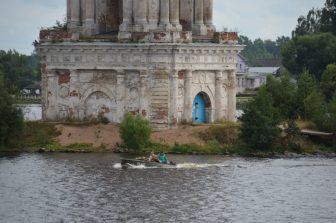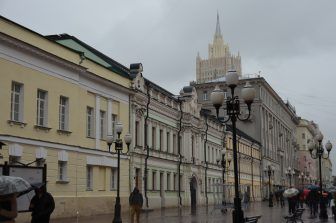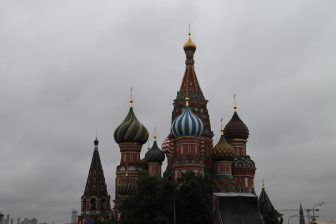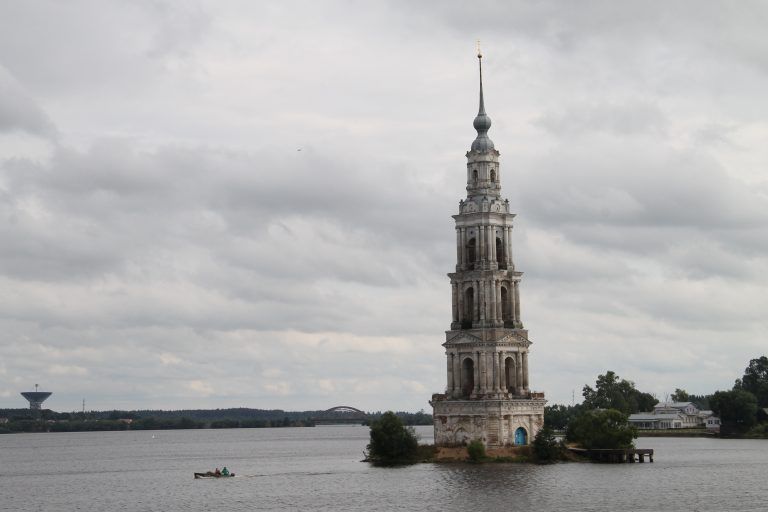
[ Aug.2017 ] Our cruise trip in Russia continues.
After leaving Uglich, we saw a clear-cut tall tower on the water.
This is known as the Bell Tower of Kalyazin which used to be a bell tower of St. Nicholas Cathedral in the town of 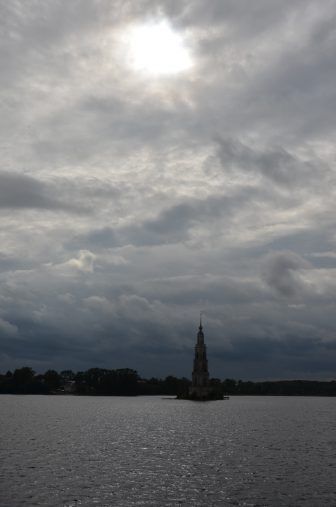
This tower whose height is 75 metres was originally built in 1800.
Apparently we sailed above a market which was near the cathedral.
Kalyazin was an old town with the history since the 12th century and it was famous for crafts, such as felt and leather and also gardening.
In the 19th century, there was a weaving mill, a food processing plant and shipyards in the town and the trading port was thriving because it was situated at the important spot on Volga River.
But because of building the reservoir, the water level went up by 12 metres in 1940 and the town sank.
The reason why the Soviets gave up this affluent town is maybe because this town was not only important economically but also religiously.
There was a monastery and churches around here, one of which was called Makaryevsky Monastery built in the 15th century regarded as very important.
In the Soviet era when they rejected religions, the reservoir was much more important than the monasteries, so they did not mind letting them go under the water.
The town of Kalyazin was moved to the higher ground and apparently it still exists.
After that, our boat went into the Moscow Canal.
This is a long canal of 128 km which connects Volga River and Moscow River.
The person who originally thought of building this canal was Peter the Great in the early 18th century, but the one who completed it was Stalin.
They took only 4 years and 8 months between 1932 and 1937 to build 8 hydroelectric stations, 11 locks, 11 dams, 19 bridges and so on.
The builders were mainly political prisoners so they did not have to spend so much money.
The working condition was terrible and the number of the death is said somewhere between 20000 and a half million.
“The reason why the number is not clear is that the supervisors were killed, too” said our tour leader.
The completion of this canal allowed Moscow, the inland city to link with 5 seas — White Sea, Baltic Sea, Caspian Sea, Sea of Azov and Black Sea.
The purpose of the canal was not only transportation but also to supply water of Volga River to Moscow.
On top of these things, we learned various things during our briefings and Q&A sessions on the boat.
For example, in the Soviet time, there were more than 70 closed cities where living and travelling were strictly restricted, but even now there are 47 of them.
They are mainly nuclear power related industrial cities.
In those closed cities, the salaries are high, the tax is low and there are many privileges, for example they can watch the new films on the next day of the releases in Moscow.
So people like them and they do not want to abolish them.
Another issue we talked about was the relationship between Russia and Ukraine.
Elena, the manager of the boat was originally from the eastern part of Ukraine and she said that she believed the result of the 2014 referendum in Crimea is genuine, which most of the people supported to join Russia.
On this point I agree with her, because when we went to Crimea, people we met there were all Russians including our guide.
According to her, in Finland, though only 6% of the population is Swedes, Finnish and Swedish are both official languages, but in Ukraine though as many as 40% are Russians, Russian language is not allowed to use and Russian schools were closed down.
I enjoyed learning so many different things, such as the dissolution of the Soviet Union and Gorbachev’s intention, Vietnamese people making shoes, about Roman Abramovich and so on.

